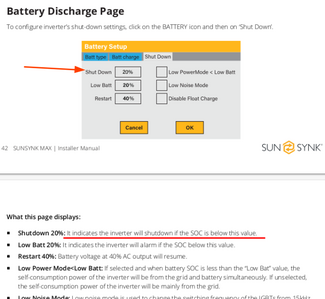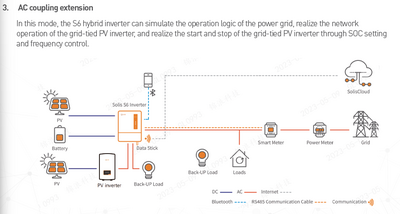Posted by: @transparentI think there will be only ONE oscillator in the inverter which provides 50Hz when the grid is down.
You can't have multiple sources for the same reference frequency!
My suggestion would be to focus on the function. The goal of that oscillator is ultimately to set the 50Hz for the AC outputs that are separate from the grid.
Posted by: @transparentIf you receive email messages from Solis tech-support staff stating that there are oscillators (plural), then I hope you'd
take a snapshot and post the images here.
Who says what, and in what context, is important.
I would, but my focus is to make sure that my current and future 'use cases' will be supported, potential value of external ATS, extra loads, etc.
As an example, a simple config change and now the Solis also boots from grid AC, which stops the battery being a single point of failure.
When I get a chance to test that 4ms failover from blackouts I will report.
Posted by: @transparentI don't like that because it leaves you without any 30mA trip protection on the external supply cable.
Yes, but least the other inverter related circuits can be protected. Hybrid inverter installs without full 30ma protection will not stand out on many "fuseboards".
Thinking ahead, when connecting PV to this Solis inverter, there seem to be two main options:
- PV can be connected to DC ports directly via MPPT. There are two sets, in our case we will never need more.
- a small inverter could be used to connect PV and output AC to the smart port of this inverter.
From an efficiency viewpoint, what would currently be the best way to do it?
16kWh Seplos Fogstar battery; 8kW Solis S6-EH1P8K-L-PLUS hybrid inverter; Ohme Home Pro EV charger; 100Amp head, HA lab on mini PC
Posted by: @batpredAs an example, a simple config change and now the Solis also boots from grid AC, which stops the battery being a single point of failure.
From my experience with inverters from different Far East manufacturers, starting the inverter can be affected by the preferences you configure, and which combination is currently available.
You have three potential inputs, plus a "smart port".
Most hybrid inverters allow you configure the preferential order in which those inputs will be chosen to supply the output(s).
You can sometimes find that the firmware 'refuses' to overlook an input which is currently not available.
or, perhaps worse, is that firmware won't switch back to your chosen input priority-list after it completes a timed event.
I've often encountered inverters which stubbornly continue supplying the 'house load' directly from the grid once they've recharged the battery overnight at cheap rate.
Aagh!
Posted by: @batpred... when connecting PV to this Solis inverter, there seem to be two main options:
- PV can be connected to DC ports directly via MPPT. There are two sets, in our case we will never need more.
- a small inverter could be used to connect PV and output AC to the smart port of this inverter.
Use both inbuilt MPPT ports.
Don't attempt the second option.
Whatever 'smart' functionality is available via that port, you don't want to be putting two inverters in series.
Try thinking of that smart-port as if it's where you connect a generator on a farm in the Australian outback!
Save energy... recycle electrons!
Quick update. 😐
1. The Solis inverter ias turning out a solid and expandable bit of kit. It does "clean" some of the electrical imperfections of my DNO's grid neutral feed not being "really neutral" (background to electricity and its phases at street level by @transparent):
a) "bleeding" neutral to earth (@transparent may be able to help with DNO responsibilities). This restricting the use of RCD to protect cables.
b) "leaky" is a non technical term that has been used to describe inverters designed to do this. It implies to the reader as a leak would be seen as needing covering up. Also suggests an impact on inverter efficiency. I am yet to see a structured discussion on that. Meters would surely measure the live cable. So this "cleaning" will not have any impact on what you pay your utility. And the cleaning of these dirty electricity flows is such a low current...
The pros and cons of a vs b are not obvious... We have very few people interested here. I'd argue the most important is to make sure the inverter does what is needed, is well supported, supports many protocols for batteries and whatever else it will talk to, is efficient, etc
2. Fogstar SEPLOS is the one where the old 1.3 firmware cannot be updated after over a week of calls.
It should be said that I used plenty of products costing a tiny fraction of what these batteries did over the last few decades. Those firmware updates usually work first time, with robust processes around it, etc.
What I am experiencing here is abnormal. Organizations have governance in place to do something about the pain caused. I did experience abnormal behaviour before (with another product player in this "ecosystem") but this is not common.
@transparent, if you worked with Fogstar for a long time, others may be interested. But if someone buys an oven and when it does not start, everybody else is pointed to a new model from the same supplier, it may not help. Not until someone can comment on their experience with that oven?
A example of a recent firmware upgrade has been the Solis hybrid inverter, a cheaper product. Their support engineers did the initial firmware upgrade. To be honest, a lot more can go wrong on that upgrade. They asked all the right questions, so I had no reason to worry when they were doing it. I am sure Fogstar can do this through process improvement.
16kWh Seplos Fogstar battery; 8kW Solis S6-EH1P8K-L-PLUS hybrid inverter; Ohme Home Pro EV charger; 100Amp head, HA lab on mini PC
Since this has come alive again - I'll give an update
Sunsynk 5.5k Ecco
15.5Kwh Battery Fogstar
So far, Fit and forget - has worked (mostly) flawlessly since the firmware update to the PACE BMS on the battery.
Has saved me good money.
One quirk - I cannot get the battery to discharge below 15% - if it hits below that it instantly charges from grid, called for by the BMS.
I haven't cared enough to look at it.
Everyday - charge to 100% - discharge to 15% TOU. perfect.
Sidebar, just completed my solar panel frame on Sunday. Plan to add panels onto my system this weekend.
14 panels, 7 on each MTTQ - ground mount.
Evolution.
Posted by: @ggwSince this has come alive again - I'll give an update
Sunsynk 5.5k Ecco
15.5Kwh Battery Fogstar
Ah, great timing, you have a different model of the oven! 😉 Mine is slightly higher capacity..
Did you assemble it yourself and what "CAN protocol" does it use to talk to the inverter?
Posted by: @ggwOne quirk - I cannot get the battery to discharge below 15% - if it hits below that it instantly charges from grid, called for by the BMS.
I haven't cared enough to look at it.
Yup, I got that vibe from @transparent
Until it is running as they stated that it should, mine cannot even be checked.
16kWh Seplos Fogstar battery; 8kW Solis S6-EH1P8K-L-PLUS hybrid inverter; Ohme Home Pro EV charger; 100Amp head, HA lab on mini PC
Posted by: @ggwI cannot get the battery to discharge below 15% - if it hits below that it instantly charges from grid, called for by the BMS.
Well the BMS on its own can't initiate a Charge from Grid.
It requires the Sunsynk inverter to handle the matter.
What happens if you simply disconnect the data cable (CAN or RS485) which links BMS and inverter?
That would be safe to try.
The BMS would normally have a lower threshold which prevents cell damage from a complete discharge.
That's independent from the 15% which you seem to have objections to.
Remember you don't even have to retain the original BMS which was supplied in a battery box.
Provided you're happy to run a fresh set of 17 balance wires (with the matching new BMS connector) you can choose whichever one you want.
Which BMS do you have in your Fogstar enclosure @ggw ?
Save energy... recycle electrons!
It's is a PACE BMS.
15% just seems to be a little high, I would run it to at least 10% if I could. But ain't cared enough to prioritise figuring it out. PBMS would likely tell me.
If I disconnect the Comms cable, the inverter errors, no Comms, and all stops and house just feeds from grid. Quite simple.
Posted by: @transparentRemember you don't even have to retain the original BMS which was supplied in a battery box.
😉 😉
Some folks get spare BMSs..
16kWh Seplos Fogstar battery; 8kW Solis S6-EH1P8K-L-PLUS hybrid inverter; Ohme Home Pro EV charger; 100Amp head, HA lab on mini PC
Posted by: @ggwIf I disconnect the Comms cable, the inverter errors, no Comms, and all stops and house just feeds from grid.
That's odd.
I can't see anything in the Sunsynk manual which suggest that to be the case.
The inverter can detect there's a battery connected without needing to be told by a data link.
I might try setting that up here to see what I discover.
Save energy... recycle electrons!
@ggw I'm reading the Sunsynk ECCO manual and I've found some relevant information about low-battery settings:
That's a pretty strong indication that you can put whatever percentage you want in that field.
Typically for Sunsynk, they haven't properly defined what they mean by "the inverter will shut down".
I'm going to assume that this isn't a total blackout.
If the grid is 'live' then it must surely continue to run loads from the grid...
... and will thus be able to recharge the battery to whatever value you enter in the Restart field.
What they should've written was...
If low-battery occurs due to loss of the grid connection, and there is no generator attached, then the figure in the Shut Down field will cause the inverter to stop working.
This protects your battery from damage due to overly-low voltages on the cells.
And they should also have explained the possibility that the BMS may intervene first.
It too will have at least a simple 'Low-volts Protect' parameter setting.
If that BMS parameter is configured higher than that on the ECCO Inverter, then the BMS effectively overrides whatever you configure on this panel.
The people who write these Sunsynk manuals are too well experienced in what is meant to happen.
They incorrectly assume that the customers are equally knowledgeable, which is unlikely.
I'm going to continue reading....
Save energy... recycle electrons!
I should've read further before posting the above.
What we learn from this is that SunSynk believe that their inverter should send commands to directly configure the BMS.
That's not particularly user-friendly.
There will a lot of parameters which can be configured on a BMS (using the battery-manufacturer's App) which do not get set or overridden by the SunSynk inverter.
How should the user know which those are,
and whether setting them directly might yield better results.
An example of such a parameter would be the settings which dictate when the BMS will perform cell balancing.
Possibilities include:
- only perform cell balancing whilst the battery is being charged
- only perform balancing when the battery is being charged and the SoC is already above 80%
- perform balancing when the battery is being charged, and for N-minutes after it has reached 100% capacity
Save energy... recycle electrons!
Posted by: @transparentPosted by: @batpred... when connecting PV to this Solis inverter, there seem to be two main options:
- PV can be connected to DC ports directly via MPPT. There are two sets, in our case we will never need more.
- a small inverter could be used to connect PV and output AC to the smart port of this inverter.
...
Whatever 'smart' functionality is available via that port, you don't want to be putting two inverters in series.
Try thinking of that smart-port as if it's where you connect a generator on a farm in the Australian outback!
😁Yes, the 90Amps capacity in total in an 8k inverter seemed unbelievable.
To get that out of the system, a complex setup is needed.
So the smart port is used elsewhere in the english speaking globe, to leverage solar:
Not one for me, I would need far too much info about the protocol the Solis would use to drive a grid-tied PC inverter like:
- what PV inverter would be supported (and would it keep working across firmware, etc upgrades)
- something seems to be missing from this diagram, when they mention "grid-tied"...
16kWh Seplos Fogstar battery; 8kW Solis S6-EH1P8K-L-PLUS hybrid inverter; Ohme Home Pro EV charger; 100Amp head, HA lab on mini PC
- 26 Forums
- 2,356 Topics
- 53.4 K Posts
- 249 Online
- 6,017 Members
Join Us!
Worth Watching
Latest Posts
-
RE: Octopus Cosy Heat Pump Owners & Discussion Thread
@kevh with the Cosy 6 I know it definitely goes to arou...
By HarrisonC , 12 hours ago
-
RE: Setback savings - fact or fiction?
@cathoderay yes I am familiar with SQL. Interesting num...
By RobS , 13 hours ago
-

Parsnip, Bacon & Coconut Milk Soup
First let me say, I am only a cook because I am human a...
By Toodles , 13 hours ago
-

RE: Controlling Daikin Altherma via P1P2 and Home Assistant
@weoleyric Oh Dear, I don’t think I am going to be of m...
By Toodles , 14 hours ago
-
RE: Electricity price predictions
Ben Watts posted on LinkedIn that he had updated this w...
By Judith , 19 hours ago
-

RE: The good, the bad and the not that great – my heat pump installation
Small update, Emailed and Spoke to Midea UK and they ...
By Burtis , 19 hours ago
-
RE: Solis S6-EH1P8K-L-PLUS – Why I Chose It and What I’ve Learned So Far
@bash Octopus does charge for the admin. The process al...
By Batpred , 20 hours ago
-
RE: External pipework insulation
@transparent HI all The products you mention are ver...
By David Smith , 20 hours ago
-
RE: New Fogstar 15.5kWh upright solution
Issues still under investigation by Solis... Fogstar ...
By Batpred , 20 hours ago
-
RE: Who's your electricity provider and what's your tariff?
I agree, the consumer is not being properly represented...
By Batpred , 20 hours ago
-
RE: Advice on internal circulation pump noise
Thanks @mikefl - I'll maybe have a look at the lock-shi...
By jtg , 2 days ago
-

RE: Heat Pump Heats the House… But It’s Not Cosy. Emitter Changes or System Tweak?
@toodles interesting suggestion, thanks. I will try to...
By GrahamF , 2 days ago
-
RE: Mitsubishi Ecodan Auto Adaption trial to stop cycling.
The interval you talk of, i think, will be 60min for an...
By F1p , 2 days ago
-
Agree with @majordennisbloodnok on the setbacks. We hav...
By ChandyKris , 2 days ago
-

RE: Speedcomfort radiator fans
@deltona the way the links were added broke the page. A...
By Mars , 3 days ago
-

RE: Refrigerant R32, is it now banned in the EU from 1st Jan 2027 for monobloc ASHPs?
This has been delayed from what I believe to be this ye...
By dgclimatecontrol , 3 days ago
-
RE: Are We Sleepwalking Into Another Race to the Bottom?
this is why I provided current flow temperatures in the...
By ksim , 3 days ago
-

RE: Why Millions of UK Homes Struggle With Heat Pumps
There's many homes that would be quite a disruption for...
By dgclimatecontrol , 3 days ago
-
RE: Ecodan unable to hit legionella target temp - what's the consensus?
@rhh2348 ...maybe this option is what you want? Alter...
By benson , 3 days ago







